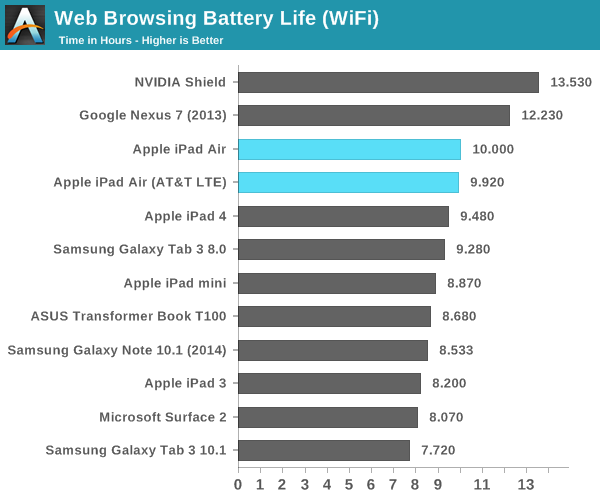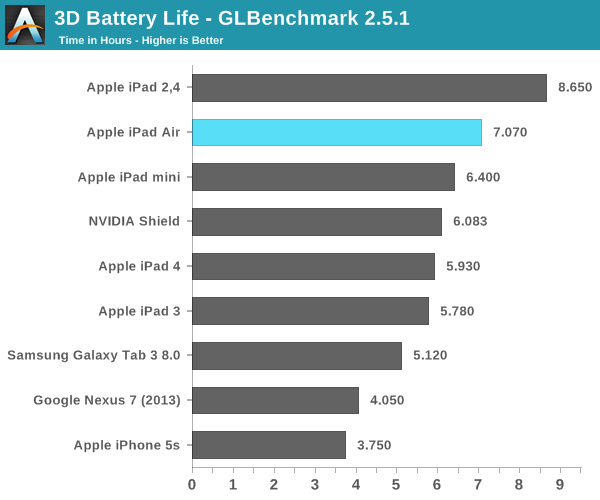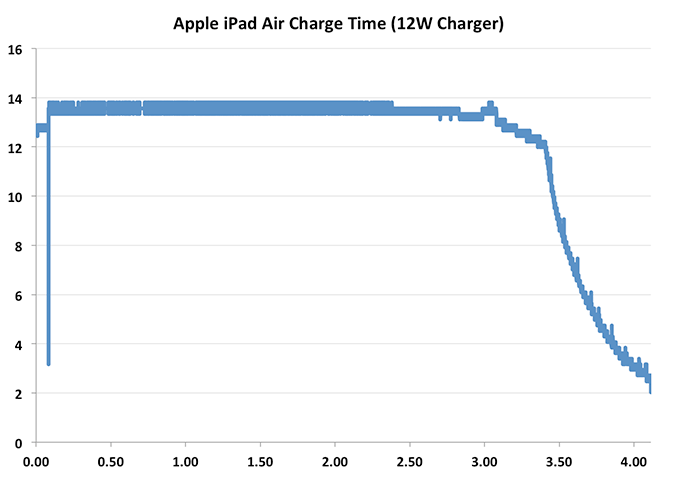The iPad Air Review
by Anand Lal Shimpi on October 29, 2013 9:00 PM ESTBattery Life
With the iPad Air Apple moved to a 32.4Wh battery, a significant decrease from the 42.5Wh unit in the 3rd and 4th generation iPads. The smaller battery doesn’t come with a change to Apple’s claim of 10 hours of battery life, which implies a reduction in overall platform power. I confirmed a substantial reduction in platform power in my crude measurements earlier in the article. Although it’s possible for the iPad Air to draw substantially more power than the iPad 4, our earlier power data seems to imply that it’s unlikely given the same exact workload. Our battery life tests agree.
We'll start with our 2013 smartphone/tablet web browsing battery life test. As always all displays are calibrated to 200 nits. The workload itself is hidden from OEMs to avoid any intentional gaming, but I've described it at a high level here.

Our web browsing workload came in at exactly 10 hours of continuous usage - an improvement compared to the iPad 4. Battery life on LTE was good as well, consistently delivering just under 10 hours of usage. The fact that both LTE and WiFi tests deliver similar results tells me that we may be bottlenecked by some other component in the system (perhaps display?).
I've been running the same video playback test for a while now, although we're quickly approaching a point where I'll need to move to a higher bitrate 1080p test. Here I'm playing a 4Mbps H.264 High Profile 720p rip I made of the Harry Potter 8 Blu-ray. The full movie plays through and is looped until the battery dies. Once again, the displays are calibrated to 200 nits:

Video playback battery life also improves slightly compared to the iPad 4. Apple’s battery life claims aren’t usually based around video playback, so exceeding their 10 hour suggestion here shouldn’t come as a shock. Apple’s video decode power has always been extremely low.
Our final cross-platform battery life test is based on Kishonti's Egypt HD test. Here we have a loop of the Egypt HD benchmark, capped to 30 fps, running on all of the devices with their screens calibrated to 200 nits.

Our 3D battery life rundown test shows a substantial improvement in battery life over the iPad 4. IMG’s PowerVR G6430, running a moderate workload, can do so more efficiently than any of the previous generation GPUs in Apple’s SoCs. Much like the A7’s CPU cores however, there’s a wider dynamic range of power consumption with the G6430. Running at max performance I would expect to see greater GPU power consumption. The question then becomes what’s more likely? Since the majority of iOS games don’t target the A7 (and instead shoot for lower end hardware), I would expect you to see better battery life even while gaming on the iPad Air vs the iPad 3/4.
Charge Time
The iPad Air comes with the same 12W USB charger and Lightning cable that we first saw with the iPad 4. Having to only charge a 32.5W battery means that charge times are lower compared to the iPad 3 and 4:

A full charge takes a little over 4 hours to complete. The adapter delivers as much as 12W to the iPad, drawing a maximum of 13.5W at the wall. I still think the sweet spot is somewhere closer to 2.5 hours but that’s another balancing game that must be played between charge time and maintaining battery health. It’s still so much better than the ~6 hours of charge time for the iPad 3 and 5.69 hours for the iPad 4.











444 Comments
View All Comments
stingerman - Sunday, November 3, 2013 - link
Yes, I haven't even seen one of those in use other than commercials. Real failures...stingerman - Sunday, November 3, 2013 - link
lol, you're hilarious! iOS is Unix plus all the major OS X frameworks plus all the new iOS frameworks... It maybe light because of its elegance, but it's a light nuclear weapon...lilo777 - Sunday, November 3, 2013 - link
LOL. Do you know any version of Unix that does not have a file system (exposed to user)?Krysto - Friday, November 1, 2013 - link
Offtopic, but Anand, the announcement of Mali T760 is suspiciously missing from this site.Over 300 GFLOPS, which is more than PS3 and should make it pretty competitive with mobile Kepler, along with ASTC compression by default, much more efficient, and has some interesting features like hardware assisted global illumination.
ARM's announcement:
http://community.arm.com/groups/arm-mali-graphics/...
michael2k - Friday, November 1, 2013 - link
Yeah, the T700 series is for next generation devices, or in other words, products in the next 12 months. The PowerVR6 series is available now for this generation and up to 1000 GFLOPS.Krysto - Saturday, November 2, 2013 - link
Do you see that 1000 GBFLOPS in any smartphone? Just because it can be scaled that much, doesn't mean they WILL for smartphones. This GPU will be used in smartphones a year from now. What does the GPU in Apple's A7 have now? ~100 GFLOPS?Anyway, the Mali T760 seems very competitive with what will be out there a year from now, and Anandtech usually writes about these sort of announcements.
michael2k - Monday, November 4, 2013 - link
I think you've missed the point.1) We aren't in a smartphone thread
2) The PowerVR6 will scale to 1000 GFLOPs; so when the T700 comes out next year, the PowerVR will be ready
3) The Air is at about 115 GFLOPs, about 2x the outgoing iPad 4, and will therefore be approximately 230 GFLOPs in the A8 next year, if 2x, or 340 GFLOPs if 3x
So you are correct that the Mali T760 will be competitive next year, but this article is about this year.
michael2k - Monday, November 4, 2013 - link
You've missed the point.The PVR6 is 115GF today in the Air, and when needed to compete with the T700 can hit 300GF.
Likewise, we are in a thread about tablets, where it is much more likely to scale to the needed 300GF.
Krysto - Saturday, November 2, 2013 - link
What you said also reminded me of how Intel promoted "Haswell graphics"."Hey, look, out "Haswell GPU" (Iris Pro 5200) is 3x faster than IVB!" - and then you only see crappy 4600 in most devices, including the Surface Pro, which is only 20 percent faster than last year's IVB GPU.
Or "look at our awesome new 2.6 Ghz Silvermont CPU's! - and then you only see 1.3 ghz Silvemont for tablets, because the 2.6 Ghz ones are not viable either because of too high TDP or price, which makes them pretty irrelevant. What's relevant is what will be in the market, not their pie-in-the-sky CPU's that never get on the shelves.
ashleyuv - Saturday, November 2, 2013 - link
This is a very interesting review, even for someone without the tech or IT background to follow all of it. In particular, I like the way, in the last part, you show how the increase to 64-bit and the DRAM size (remaining the same), while seeming like a no-brainer and conservative decisions, respectively, are actually a smart play, albeit one with consequences.In agreement with one of your readers, I'd have to say that "review" is really the wrong word for this. It is all but a scientific study. But again, it's written for people who may not have an extensive tech background.
Thank you! I will be reading more in the future (just discovered your site).